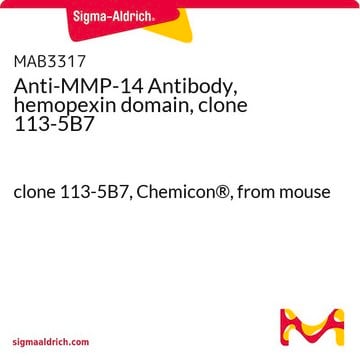MAB3328
Anti-MMP-14 Antibody, catalytic domain, clone LEM-2/15.8
clone LEM-2/15.8, Chemicon®, from mouse
Sinonimo/i:
MT1-MMP
About This Item
Prodotti consigliati
Origine biologica
mouse
Livello qualitativo
Forma dell’anticorpo
purified immunoglobulin
Tipo di anticorpo
primary antibodies
Clone
LEM-2/15.8, monoclonal
Reattività contro le specie
mouse, human
Confezionamento
antibody small pack of 25 μg
Produttore/marchio commerciale
Chemicon®
tecniche
ELISA: suitable
immunoprecipitation (IP): suitable
western blot: suitable
Isotipo
IgG1κ
N° accesso NCBI
N° accesso UniProt
Condizioni di spedizione
ambient
Temperatura di conservazione
2-8°C
modifica post-traduzionali bersaglio
unmodified
Informazioni sul gene
human ... MMP14(4323)
Descrizione generale
Specificità
Immunogeno
Applicazioni
Cell Structure
MMPs & TIMPs
Immunohistochemistry: Frozen and paraffin-embedded tissues
Immunofluorescence
Flow Cytometry
Blocking: 10-15μg/mL
Optimal working dilutions must be determined by the end user.
Stato fisico
Stoccaggio e stabilità
Altre note
Note legali
Esclusione di responsabilità
Not finding the right product?
Try our Motore di ricerca dei prodotti.
Raccomandato
Codice della classe di stoccaggio
12 - Non Combustible Liquids
Classe di pericolosità dell'acqua (WGK)
WGK 2
Punto d’infiammabilità (°F)
Not applicable
Punto d’infiammabilità (°C)
Not applicable
Certificati d'analisi (COA)
Cerca il Certificati d'analisi (COA) digitando il numero di lotto/batch corrispondente. I numeri di lotto o di batch sono stampati sull'etichetta dei prodotti dopo la parola ‘Lotto’ o ‘Batch’.
Possiedi già questo prodotto?
I documenti relativi ai prodotti acquistati recentemente sono disponibili nell’Archivio dei documenti.
Il team dei nostri ricercatori vanta grande esperienza in tutte le aree della ricerca quali Life Science, scienza dei materiali, sintesi chimica, cromatografia, discipline analitiche, ecc..
Contatta l'Assistenza Tecnica.








